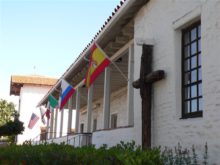Museum Repair ProjectPreserving our past for future generations
Cracks and holes in the rock retaining wall and adobe exterior wall on the west side of the building were discovered in 2020. Investigation by a team of structural and geotechnical engineers in 2021 determined the soil was settling beneath the southern portion of the building and the retaining wall below the adobe was sinking and moving outward towards Mission Blvd. This movement created exterior and interior cracks in the foundation, retaining wall, and adobe brick. It was also causing the exterior stucco and original mud plaster to spall off, exposing the underlying adobe to water damage. The engineering studies concluded the building was in danger of partial collapse in the event of a moderate earthquake on the nearby Hayward fault or a major earthquake on another Bay Area fault. Beginning in 2022 the parish has repaired the mission clay tile roof, replaced missing and leaking rain gutters, and replaced the failing sections of the foundation and retaining wall. Click here to see pictures of the foundation and retaining wall replacement, completed in February 2024. In June 2025 the parish will begin repairs to the museum building’s exterior walls. This work could not begin until the foundation and retaining wall repairs were completed, as they were one cause for the cracks in the adobe and stucco walls. The cracked and spalling mud plaster and stucco surfaces provide a path for water intrusion leading to more cracking and spalling and eventual erosion of the underlying original adobe brick. Resurfacing the mud plaster and stucco exteriors will prevent water infiltration and further damage to the adobe brick walls. We will also replace leaking and weather-damaged wood sash windows and exterior wooden doors. Help us preserve our 1809 Mission Museum for future generationsThe total cost of repairs to the Museum building are approaching $1 million. As part of the Mission’s 225th anniversary we raised $100,000 towards the cost of repairs. Additional donations are raised during each year’s Mission anniversary celebration. We have also received $180,206 in grants from the Committee for the Restoration of Mission San Jose, a $50,000 grant from the Fremont Bank Foundation, a $25,000 grant from Alameda County, and $16,165 from the California Missions Foundation. The parish has used $537,110 through 2024 for Museum repairs from repurposed capital campaign donations, Mission Anniversary fundraising and Museum renewal donations. More funding is needed to repair and restore the cracked and spalling stucco and mud plaster coating that covers and protects the building’s historic adobe brick walls, and to repair and preserve the building’s wood windows and exterior doors. Click HERE to become part of our history with a donation to this project. |
|
|

 The Mission museum is the original 1809 adobe Convento, the former Padres’ living quarters. It is the oldest standing building in Alameda county. Its importance is recognized by the National Register of Historic Places and the California State Historic Landmarks Commission.
The Mission museum is the original 1809 adobe Convento, the former Padres’ living quarters. It is the oldest standing building in Alameda county. Its importance is recognized by the National Register of Historic Places and the California State Historic Landmarks Commission. 